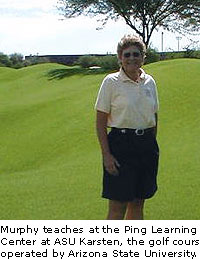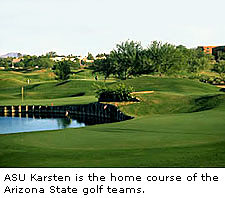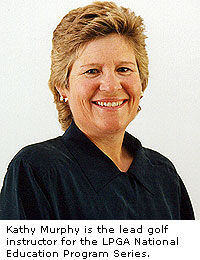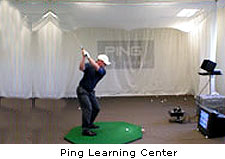Golf instructor Kathy Murphy sits down to talk about her trade
 TEMPE, Ariz. -- Are women better golf instructors than men? Do they have better training than male golf teachers do? And what are some of the things that make a good teacher of either sex?
TEMPE, Ariz. -- Are women better golf instructors than men? Do they have better training than male golf teachers do? And what are some of the things that make a good teacher of either sex?
We talked about some of these questions with Kathy Murphy, an instructor in the Ping Learning Center, a golf school that's open to the public as well as students at Arizona State University's Karsten Golf Course.
Murphy has been teaching golfers for 25 years and has won a host of honors along the way. In the past year, she was chosen best teacher in Arizona by Golf Digest and one of the top 50 teachers in America by Golf for Women Magazine. In 2001, she was chosen as the LPGA teacher of the year.
She's now a lead instructor with the LPGA -- teaching golf professionals how to teach. She also served two years as the volunteer coach for the ASU Women's Golf Team. "I like the way that Kathy enunciates and takes time when she teaches," LPGA member Kim Hilbert says about LPGA classes she attended where Murphy taught. Hilbert, who teaches at the Ables Golf School in Columbus, Ohio, also says, "I have a tendency to talk quickly, too fast, and answer questions before people finish asking them. She really helped me with information on how people learn."
You see the same skills displayed when Murphy works with amateur golfers. She asks students a lot of questions about their game and actually seems to get them to find the answers to their problems by themselves rather than telling them what to do. Murphy has had extensive experience with junior golfers including many of the top-ranked high school players in the state. In her personal brochure for prospective students, Murphy talks about "golf education" and "sessions" and "learning." She doesn't talk about "teaching" or "lessons." It's a subtle difference, but it seems to reflect her basic philosophy about learning and improving your game.
 Here is some of what Murphy had to say:
Here is some of what Murphy had to say:
TG: What drew you to golf and when?
Murphy: I got interested when I was 11 (I was born in 1952). Golf was just not that cool back then, but I found it fascinating to watch on TV. I loved Arnold Palmer, and I was interested in Mickey Wright and Carol Mann. I used to take a wedge and a bucket into my backyard, and I'd keep trying to drop the balls in the bucket.
TG: And how did that lead to teaching?
Murphy: When I graduated in 1973 with a P.E. major, I went home to Danville, Ky., and worked for the professional in the local golf club. He suggested going to Florida for the winter if I wanted to play professionally, and I did. I played in a year of amateur competition golf and in small invitational tours in Kentucky. I played in some national amateur events. I went to my first qualifying school for the LPGA in the summer of '78; Nancy Lopez was there and qualified. I didn't miss by much. But then I went to another winter Q school in Sarasota and it quickly became clear to me that playing was not my calling. I didn't have the skills or the drive.
Then I became a head professional at Plantation Golf & Country Club in Venice, Fla., and I was there for 10 years. In that job, I started doing a lot of teaching. I got involved with the LPGA and their vision for being leaders in teacher education.
After working for a while in the Northeast, I wanted to find a place where golf was year-round. I moved to Phoenix first and then got on the staff at ASU in 1996.
TG: What's your philosophy in helping golfers with their game?
 Murphy: I want to help them develop their game rather than do a Band-aid thing. You're not going to do that in an hour; you'll do better over the course of time. In the LPGA we take a student-centered approach. Our motto is: Learn the student, teach the game. Everyone plays for different reasons and it's important that that is recognized, that you find out where they are and what their goals are.
Murphy: I want to help them develop their game rather than do a Band-aid thing. You're not going to do that in an hour; you'll do better over the course of time. In the LPGA we take a student-centered approach. Our motto is: Learn the student, teach the game. Everyone plays for different reasons and it's important that that is recognized, that you find out where they are and what their goals are.
TG: Would you say that women golf teachers do better than men, particularly since LPGA professionals often go through more extensive teacher training than many men?
Murphy: It's not a gender thing; it depends on the teacher and the coach. I know a lot of good men teachers. And I'm sure there are women who are not good teachers.
PGA educational programs are more business-oriented, but they have started offering more education for golf teachers. However, they have 300 pros at a time in their teacher education classes, while the LPGA trains an average of 27 at a time.
In terms of learning, I think women often make good teachers because of their affinity for communicating and nurturing.
TG: How has golf instruction changed over the years?
Murphy: Back when I lived in Florida, the head professional at a top resort in Sarasota would give a 30-minute lesson, and he'd talk the entire time. It was more like a demonstration of some kind than a learning experience. I can't imagine that that would take place today. The people at the University of Georgia have a sports laboratory and they did some research on coaches. They found that the newer, less experienced teacher talks too much. The more experience they have, the less that they talk and they accomplish much, much more.
TG: What do women golfers say that they want to learn from you in your sessions with them?
Murphy: They say they want more distance and more consistency. Lots of students say that. But as far as consistency is concerned, golfing and a golf course is so variable that consistency doesn't mean much. Consistency is better in bowling than golf. What I interpret students to mean by the word "consistency" is that they want to learn how to perform.
TG: What's the toughest challenge you ever had as a teacher?
Murphy: I had a father come in with his five-year-old daughter for lessons. She was also taking lessons from a teacher of some elite players, but that teacher was on tour at the time. They came to me for work on her golf swing, but I also worked on her short-game shots. I took baby powder and drew pictures on the putting green. For example, a house with a windows and door and had her putt along the outer portions of the picture. We were playing a game as well as working. With a five year old, no matter how much enthusiasm she has, it has to be fun, it can't be a traditional lesson. She's still playing, in fact, in 8-year-old junior golf.
 TG: What places do you like to play in Arizona?
TG: What places do you like to play in Arizona?
Murphy: I like ASU Karsten. It's very challenging and fair. It was designed by Pete Dye and his wife, Alice, working together. It's one of the few courses designed by both a male and a female. The female tees are not just plopped out there in front of the men's. From forward or back, you have a similar experience.
I like some of the Phoenix munis, like Papago Golf Club, but it's on the tough side for women. It plays long. Aguila Golf Course at Baseline and 35th is good, too, and will benefit from the growth of its trees. Stone Creek in Scottsdale is very fair and fun to play. So is Vistal in South Phoenix. It has water, mountain and desert areas and you can see the Phoenix skyline from some holes.
May 1, 2004
Rebecca Larsen is a former features and assistant features editor for the Marin Independent Journal, a medium-sized daily paper located north of San Francisco. She has also worked for the Milwaukee Journal and for a Chicago public relations firm. She has a bachelor's in journalism from Northwestern University and a master's from the University of California at Berkeley.
 By
By